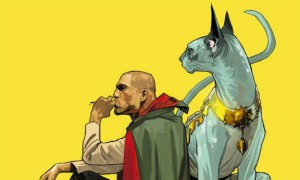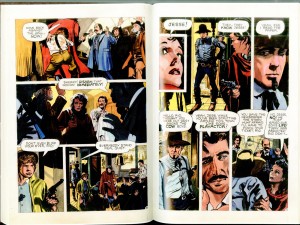I find the concept of taking children to comic book shops increasingly more difficult. Aside from the aesthetics of such shops (at least the ones near to me) that seem genuinely kid-unfriendly, most of these places have long, horizontally situated racks. The comics are placed in alphabetical order, and in a lot of cases, without much concern for content. That means that right next to Batman, your little child might also pick up Howard Chaykin’s Black Kiss, a book that proudly defines itself as pornographic. Some stores pre-bag the books, and some don’t. It is still a difficult conversation to have when the cover features a garters-and-underwear crotch shot.
 I’m not saying that books like that don’t have a place in publishing. I am saying that these establishments never made the leap from comic book store to book store, where departments allowed a certain sense of judicious partitioning. If you went to your local book store, if one actually exists near your town (more on that in a moment), and saw very mature romance novels — or let’s just take that leap and say Fifty Shades Of Grey — placed in the children’s section not by accident but in alphabetical order, you’d think someone wasn’t doing their job. If someone wants to read Crossed, with its very disturbing depictions of grisly gorings and rape, they have that right as adults, but maybe that is best classified in a sci-fi/horror section. My main assertion is that if comics is hoping to regain an audience equal to a movie audience, it must start with young kids, and adults who know what’s out in the marketplace are not comfortable with setting them loose in the modern comic shop setting.
I’m not saying that books like that don’t have a place in publishing. I am saying that these establishments never made the leap from comic book store to book store, where departments allowed a certain sense of judicious partitioning. If you went to your local book store, if one actually exists near your town (more on that in a moment), and saw very mature romance novels — or let’s just take that leap and say Fifty Shades Of Grey — placed in the children’s section not by accident but in alphabetical order, you’d think someone wasn’t doing their job. If someone wants to read Crossed, with its very disturbing depictions of grisly gorings and rape, they have that right as adults, but maybe that is best classified in a sci-fi/horror section. My main assertion is that if comics is hoping to regain an audience equal to a movie audience, it must start with young kids, and adults who know what’s out in the marketplace are not comfortable with setting them loose in the modern comic shop setting.
Another revenue stream was once the monthly subscription, where the publishers sent the books directly to your home. It was a way to lock in sales for twelve months, to ensure a growing connection between the consumer and the product, and for those kids who had subscriptions, it was like a kind of gift that arrived every five weeks. Sometimes the books weren’t terrific. I had a subscription to The Incredible Hulk during some of its leanest years. Hulk had three modes: Hulk sad, Hulk smash, Hulk flee. The art at that time was particularly weird, with artists drawing figures at strange angles, as if they were always sliding into home base. They were, in panel after panel, gritting their teeth angrily. If there were ethnic characters, they were ethnic caricatures.
 But you’d also end up with some real gems: the legendary run of Chris Claremont, John Byrne, and Terry Austin on X-Men, Bill Mantlo and Michael Golden on Micronauts, and Doug Moench and Bill Sienkiewicz on Moon Knight, Marvel’s Batman lift (in some respects). Claremont wrote a particularly stunning issue (the last, in fact) of Man-Thing where he and Man-Thing go to hell. The author wrote himself into a story where he might have lost his eternal soul, and winds up telling his friends about it in a diner later. Conceptually, that’s a great premise…and easily accessible from any newsstand, but enough flogging of that horse.
But you’d also end up with some real gems: the legendary run of Chris Claremont, John Byrne, and Terry Austin on X-Men, Bill Mantlo and Michael Golden on Micronauts, and Doug Moench and Bill Sienkiewicz on Moon Knight, Marvel’s Batman lift (in some respects). Claremont wrote a particularly stunning issue (the last, in fact) of Man-Thing where he and Man-Thing go to hell. The author wrote himself into a story where he might have lost his eternal soul, and winds up telling his friends about it in a diner later. Conceptually, that’s a great premise…and easily accessible from any newsstand, but enough flogging of that horse.
People believe the future for comics, like all other media, is digital. That might be true…only it depends on a few details. It is a perfect medium for adults with iPads and tablets, but once again neglects the youngest youth audience who will make up the strong financial long-game for the industry. Most kids interact with their parents’ tablets, not their own. If they have their own, they might not have the financial wherewithal to buy digital comics. That is, again, up to the parents and that purchase is not in their face like a newsstand rack is. That is a conscious purchase, not a impulse buy. And much as a coffee table book may never be fully displaced by a digital version, because of its very visual nature, comics can be the same, requiring the physical purchase to get that complete experience.
That’s where we cycle back to Frank Miller and Neil Gaiman, Mark Millar, Alan Moore, and the likes. Comics, that most visual medium, has been dominated by writers. Many of the artists have been saddled with a bland, house-style mandate, or are relying heavily on digital coloring and Photoshoppery to punch some life into their chests. There has never been a more interesting time to read comics, but there has never been a less interesting time to view them. Allowing for visual individualism will help, and I know deep down that if you give someone an option to have a printed image of high visual quality and hard work, versus pixels, they’ll at least consider it more.





Comments